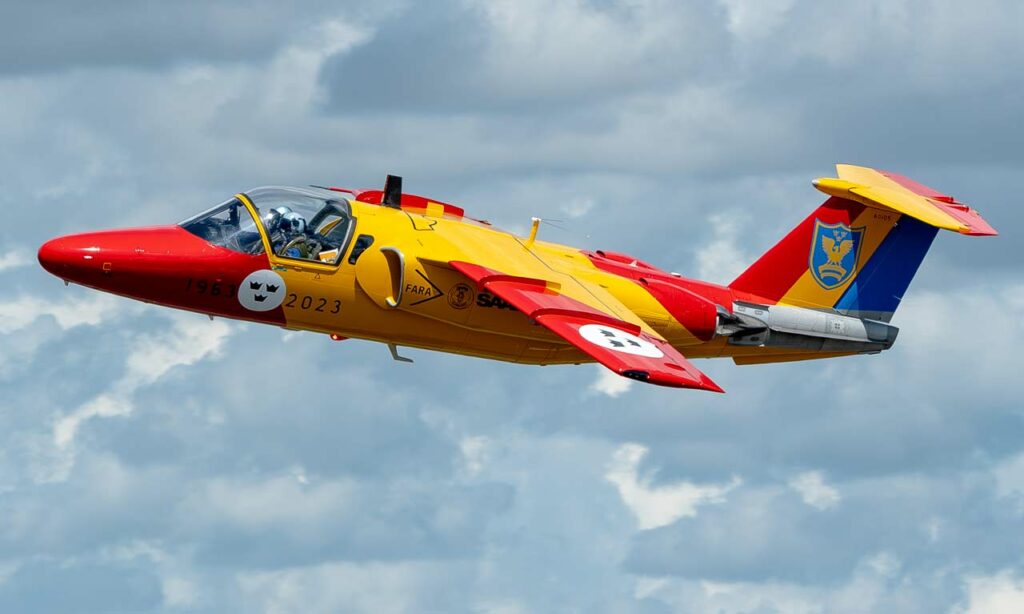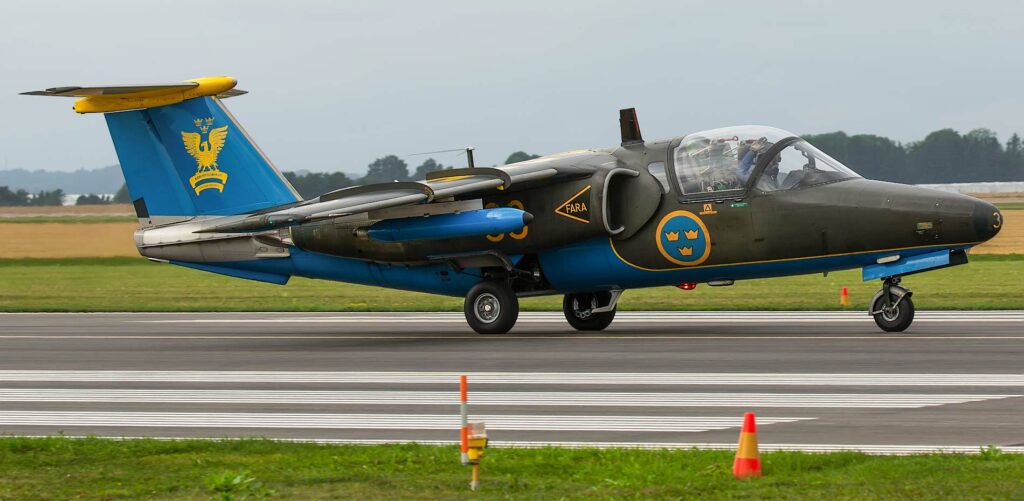The Saab 105, a versatile trainer and light attack aircraft, features twin engines and advanced avionics, serving military forces with efficiency and reliability.
In brief
The Saab 105, introduced in the 1960s, serves as a dual-role aircraft for training and light attack missions. Its design emphasizes maneuverability and adaptability. With a length of 10.5 meters and a wingspan of 9.5 meters, it can reach speeds of up to 715 km/h (445 mph) and fly at altitudes of 11,000 meters (36,089 feet). Powered by twin Turbomeca Adour engines, it offers exceptional performance and reliability for its role.
The development of the Saab 105 emerged during the Cold War era when the need for advanced trainer aircraft was paramount. Initiated in the late 1950s, the program aimed to provide the Swedish Air Force with a modern training platform capable of preparing pilots for advanced jet fighters. The Saab 105 made its maiden flight in 1963, representing a significant advancement in Swedish aviation technology. Its NATO nickname, if any, has not been officially documented.

Design of the Saab 105
The Saab 105’s design embodies efficiency and functionality. Its streamlined fuselage and swept wings optimize aerodynamics, enhancing its maneuverability. Equipped with advanced avionics and a tandem seating arrangement, it facilitates effective pilot training. However, its relatively low payload capacity and limited armament options are notable drawbacks. Nonetheless, its compact size and robust construction contribute to its durability and ease of maintenance, making it a popular choice among air forces.
Performance of the Saab 105
Powered by twin Turbomeca Adour engines, the Saab 105 delivers impressive performance metrics. With a maximum speed of 715 km/h (445 mph) and a service ceiling of 11,000 meters (36,089 feet), it offers exceptional agility and altitude capabilities. Its range of approximately 1,500 kilometers (932 miles) enables extended training sorties and light attack missions. In comparison to contemporaneous trainer aircraft, such as the BAE Hawk and Aero L-39 Albatros, the Saab 105 stands as a competitive option, balancing performance with reliability and cost-effectiveness.
Variants of the Saab 105
The Saab 105 platform has seen several variants tailored to specific roles and requirements. These include trainer variants equipped with advanced avionics for pilot instruction, as well as light attack variants featuring additional hardpoints for weaponry. Notable variants include the SK 60, SK 60A, and SK 60B, each offering distinct specifications and capabilities to suit diverse operational needs.

Military Use and Combat of the Saab 105
The Saab 105 has served prominently in various military roles, including training and light attack missions. Armed with machine guns, rockets, and bombs, it has participated in numerous conflicts, including the Cold War and regional conflicts. Notable deployments include reconnaissance missions and close air support operations. Several countries, including Austria and Sweden, have utilized the Saab 105 in their air forces, attesting to its versatility and effectiveness. While some operators have phased out the Saab 105 in favor of more modern aircraft, it remains in service with select air forces for training and light attack duties.
The Saab 105 represents a versatile and reliable platform for military training and light attack missions. Its robust design, coupled with impressive performance metrics, has ensured its enduring relevance in the aerospace industry. Despite evolving operational requirements and advancements in aviation technology, the Saab 105 continues to serve as a testament to Swedish engineering prowess and innovation.
Back to the Trainers section.